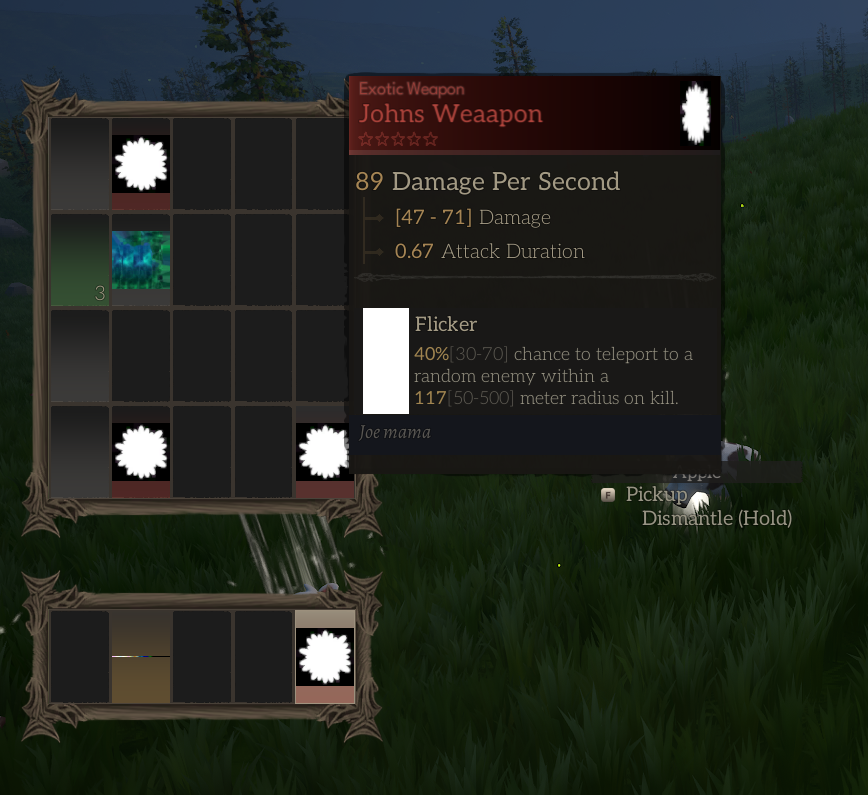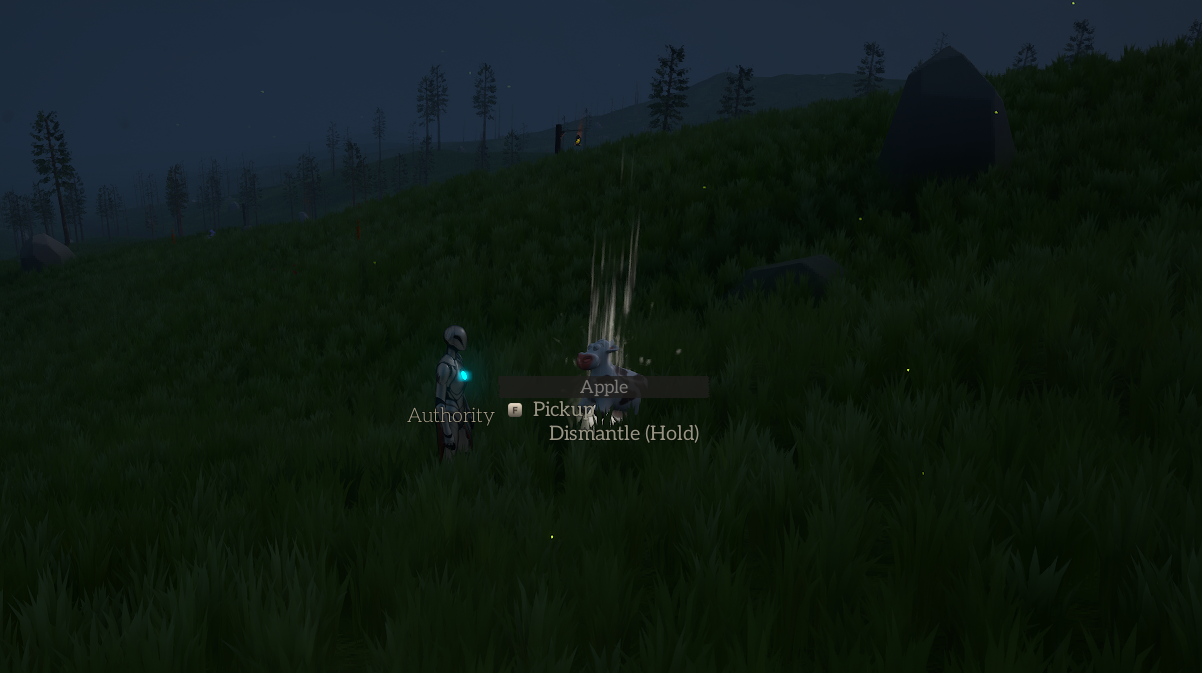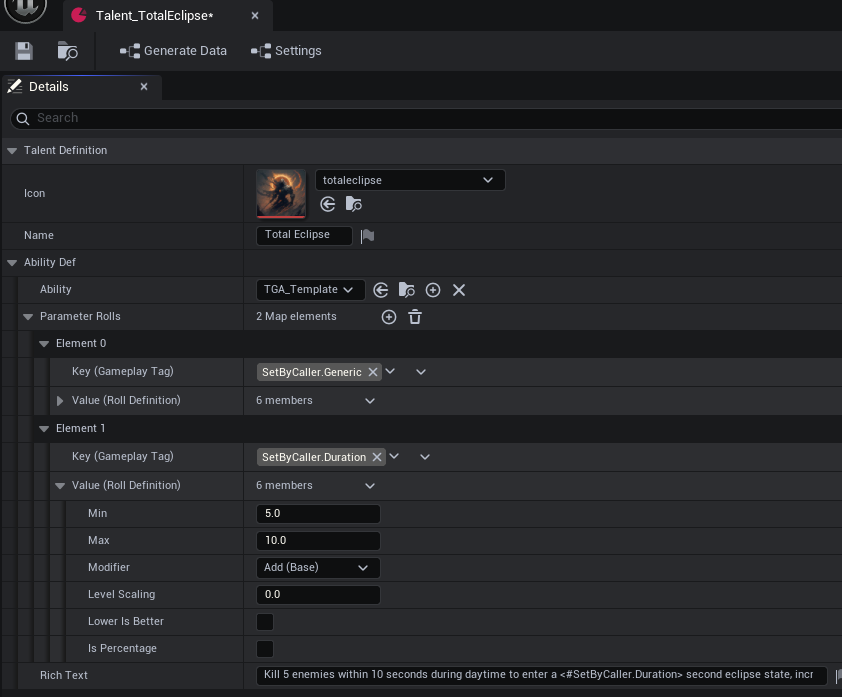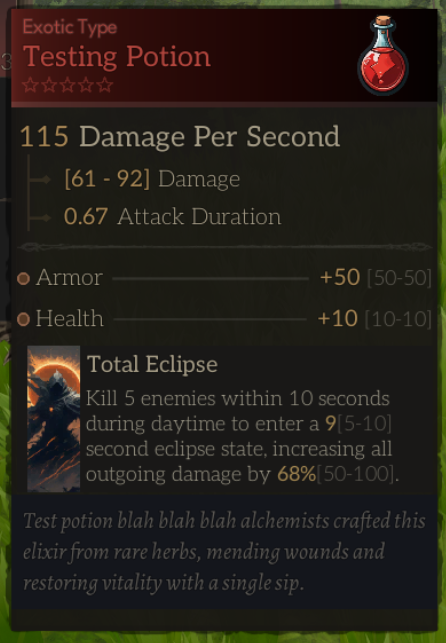This is an exhaustive breakdown of the inventory system I built for Mythic, an open-world survival game where players can explore, build, hunt, survive, and more. This system is the backbone of item handling in the game, covering everything from crafting and equipping to multiplayer replication and in-world interactions.

Part 1: Core Itemization Concepts
1. Introduction to the Itemization System
The goal of this itemization system is to allow for a vast array of loot with varied behaviors and stats, without creating a tangled mess of code. I achieve this through a few key elements:
- Item Definitions (
UItemDefinition): The data asset defining an item. Defines static properties and potential behaviors via fragments. - Item Fragments (
UItemFragment): Modular pieces of functionality that define what an item does or its characteristics. These are attached to Item Definitions. - Item Instances (
UItemInstance): A concrete, individual item that exists in the game world or an inventory. This is what the player actually owns and interacts with. - Inventory System (
UInventorySlot,UInventoryComponent): Manages a collection of item instances, organized into slots, for an actor. - World Items (
AWorldItem): Represents an item instance when it’s physically present in the game world (e.g., loot dropped by an enemy).
This component-based fragment system is a powerful paradigm for creating rich itemization, and its design here is inspired by concepts found in Epic Games’ Lyra Starter Game, showcasing a robust approach to modular game features.
This is the bigger picture for now, but don’t worry, all of this will make sense by the end of this post.
2. Item Definitions
The UItemDefinition is the starting point for any item. It’s a Data Asset that holds all the fundamental, unchanging properties of an item type. Think of it as the “master plan” or “template” for an item like “Steel Sword” or “Health Potion.”
Key strength of this system is that UItemDefinition assets, along with the properties of the UItemFragments they contain, are primarily configured by game designers directly in the Editor as Data Assets. This allows for rapid iteration on item types, behaviors, and balance without requiring code changes for each new item or adjustment. Designers can create new ItemDefinition Data Assets, assign fragments to them, and set their exposed properties to craft a huge variety of items.
Key properties of UItemDefinition typically include:
Name: The display name of the item.Description: Flavor text or a summary.ItemType: A gameplay tag categorizing the item (e.g.,Item.Weapon.Sword).Rarity: How common or rare the item is.WorldMesh: The 3D model for the item in the world.Icon2d: The 2D UI icon.StackSizeMax: Maximum stack count for this item type.Fragments: An array ofUItemFragmentobjects.
UCLASS(Blueprintable, BlueprintType)
class UItemDefinition : public UPrimaryDataAsset {
GENERATED_BODY()
public:
UPROPERTY(EditAnywhere, BlueprintReadOnly, Category="Display")
FText Name;
UPROPERTY(EditAnywhere, BlueprintReadOnly, Category="Display")
FText Description;
UPROPERTY(EditAnywhere, BlueprintReadOnly, Category="Categorization")
FGameplayTag ItemType;
UPROPERTY(EditAnywhere, BlueprintReadOnly, Category="Categorization")
EItemRarity Rarity;
UPROPERTY(EditAnywhere, BlueprintReadOnly, Category="Visuals")
TSoftObjectPtr<UStaticMesh> WorldMesh;
UPROPERTY(EditAnywhere, BlueprintReadOnly, Category="Visuals")
TSoftObjectPtr<UTexture2D> Icon2d;
UPROPERTY(EditAnywhere, BlueprintReadOnly, Category="Stacking", meta=(ClampMin="1"))
int32 StackSizeMax = 1;
UPROPERTY(EditAnywhere, BlueprintReadOnly, Instanced, Category="Functionality") TArray<TObjectPtr<UItemFragment>> Fragments;
};
The Fragments array holds the configured fragments. When an ItemInstance is made, these are duplicated and become unique to that instance.
3. Item Fragments
Item Fragments are the true building blocks of an item’s functionality. They are UObjects that define specific behaviors or data. An ItemDefinition is configured with these fragments, which are then instantiated for each ItemInstance.
Instanced fragments on an UItemInstance are typically replicated UObjects. This allows their state (like CurrentDurability on a DurabilityFragment) to be synchronized from server to clients. For more on replicating UObjects, this article by jambax.co.uk is a great resource.
The base UItemFragment.h is simple:
UCLASS(DefaultToInstanced, EditInlineNew, Abstract)
class UItemFragment : public UReplicatedObject {
GENERATED_BODY()
// virtual void OnInstanced(class UItemInstance* OwningInstance) {} // Called when fragment is instanced
// virtual void OnItemActivated(class UItemInstance* OwningInstance) {} // Called when item is equipped/activated
// virtual void OnItemDeactivated(class UItemInstance* OwningInstance) {} // Called when item is unequipped/deactivated
};
Basic Item Fragment Examples
UDurabilityFragment:- Tracks durability. Durability is consumed when the item is used (e.g., an
AttackFragmenton the same item might call a method on this fragment to consume durability after an attack).
class UDurabilityFragment : public UItemFragment { GENERATED_BODY() public: UPROPERTY(EditAnywhere, BlueprintReadOnly, Category="Durability", meta=(ClampMin="0")) float MaxDurability = 100.0f; // UPROPERTY(BlueprintReadOnly, ReplicatedUsing=OnRep_CurrentDurability, Category="Durability") // float CurrentDurability; // UFUNCTION() // void OnRep_CurrentDurability(); // void ConsumeDurability(float AmountToConsume) { /* CurrentDurability -= AmountToConsume; ... */ } // bool IsBroken() const { /* return CurrentDurability <= 0; */ } // void SetCurrentDurability(float NewDurability) { /* CurrentDurability = NewDurability; ... */ } // Added for Repair Station // float GetCurrentDurability() const { /* return CurrentDurability; */ } // Added for Repair Station // float GetMaxDurability() const { /* return MaxDurability; */ } // Added for Repair Station };An alternative durability fragment could subclass UActionableItemFragment, to make the item lose durability on use.
- Tracks durability. Durability is consumed when the item is used (e.g., an
UContainerFragment:- Represents items like a “waterskin”, “bottle”, or “quiver” that hold a specific type of substance/item and its quantity (e.g., “Water” with
CurrentWaterAmount/MaxWaterAmount). This is distinct from a general inventory bag that holds multiple, variedItemInstances.
UCLASS() class UContainerFragment : public UItemFragment { GENERATED_BODY() public: UPROPERTY(EditAnywhere, BlueprintReadOnly, Category="Container") TSoftObjectPtr<UItemDefinition> ContainedItemDefinition; UPROPERTY(EditAnywhere, BlueprintReadOnly, Category="Container", meta=(ClampMin="0")) float MaxQuantity = 100.0f; // UPROPERTY(BlueprintReadOnly, Replicated, Category="Container") // float CurrentQuantity; // bool HasSubstance(float AmountNeeded) const { /* return CurrentQuantity >= AmountNeeded; */ } // void ConsumeSubstance(float AmountToConsume) { /* CurrentQuantity -= AmountToConsume; ... */ } // void AddSubstance(float AmountToAdd) { /* CurrentQuantity += AmountToAdd; ... */ } };- Represents items like a “waterskin”, “bottle”, or “quiver” that hold a specific type of substance/item and its quantity (e.g., “Water” with
Beyond granting passive abilities or stats (which we’ll see with TalentFragment and AffixesFragment), fragments can be designed for more direct GAS (Gameplay Ability System) interactions via “Actionable Fragments”.
Actionable Fragments
UActionableItemFragment is a subclass of UItemFragment, which binds an Enhanced Input Action. Whenever the Input Action (specified by the designer) is triggered, it would call a method like OnUse that subclasses could use for variety of things.
Examples of ActionableItemFragments:
UAttackFragment: For weapons, this fragment would define properties like base damage, attack speed, critical hit chance, damage type (e.g., Fire, Ice). When equipped (viaOnItemActivated) would grant an “Attack” Gameplay Ability, andOnUsewould activate the granted ability.UConsumableActionFragment: Used for items like potions or food.OnUsewould then consume the item and apply a specific Gameplay Effect (e.g., heal the player, grant a temporary buff, restore mana).
By combining different fragments, designers can create a vast array of item types with unique behaviors without needing to create monolithic item classes for every conceivable item.
4. Item Instances
An UItemInstance is a concrete, individual item existing in the game. It’s the tangible object built from an ItemDefinition DataAsset. Also a Replicated UObject.
Key properties:
ItemDefinition*: Points to the sourceItemDefinitionData Asset.ItemFragments: Array of instantiated fragments, each with its own state (e.g., uniqueCurrentDurability).Quantity,ItemLevel,ItemTags.
Stacking: Even if an ItemDefinition has StackSizeMax > 1, instances only stack if their fragment states are identical. An “Epic Sword” with +10 Strength won’t stack with another “Epic Sword” that rolled +12 Strength. A waterskin with 50 units of water (CurrentQuantity = 50 on its ContainerFragment instance) won’t stack with one holding 75 units.
UCLASS(Blueprintable, BlueprintType)
class UItemInstance : public UReplicatedObject {
GENERATED_BODY()
protected:
UPROPERTY(BlueprintReadOnly, Category="Item" /*, Replicated */)
TObjectPtr<UItemDefinition> ItemDefinition;
UPROPERTY(BlueprintReadOnly, Category="Item" /*, Replicated */)
TArray<TObjectPtr<UItemFragment>> ItemFragments; // Instantiated fragments
UPROPERTY(BlueprintReadOnly, Category="Item", meta=(ClampMin="1") /*, Replicated */)
int32 Quantity = 1;
UPROPERTY(BlueprintReadOnly, Category="Item" /*, Replicated */)
int32 ItemLevel = 1;
UPROPERTY(BlueprintReadOnly, Category="Item" /*, Replicated */)
FGameplayTagContainer ItemTags;
public:
// UItemDefinition* GetItemDefinition() const { return ItemDefinition; }
// template <typename T> T* GetFragment() const; // Gets a specific fragment instance
// void Initialize(UItemDefinition* Def, int32 InQuantity = 1, int32 InItemLevel = 1); // Instantiates fragments
// bool CanStackWith(UItemInstance* OtherInstance) const; // Compares fragment states
};
Fragment Instantiation: When an instance is created, fragment from the ItemDefinition are duplicated into unique fragment instances on the UItemInstance. This is where an AffixesFragment rolls stats, or an instanced DurabilityFragment gets its CurrentDurability (e.g., initialized to MaxDurability from its definition template).
void UItemInstance::Initialize(UItemDefinition* Def, int32 InQuantity, int32 InItemLevel)
{
ItemDefinition = Def;
Quantity = FMath::Clamp(InQuantity, 1, Def->StackSizeMax);
ItemLevel = InItemLevel;
// Instance fragments from Item Definition
ItemFragments.Empty();
for (UItemFragment* Fragment : Def->Fragments)
{
if (Fragment)
{
UItemFragment* InstancedFragment = DuplicateObject(Fragment, this);
InstancedFragment->OnInstanced(this);
ItemFragments.Add(InstancedFragment);
}
}
}
5. Inventory Component and Slots
Inventory Slot
A UInventorySlot acts as a wrapper or container within an inventory that directly holds one UItemInstance (or a stack of them if they are stackable and identical).
- Key Properties:
ItemInstance: Pointer to theUItemInstancein this slot (replicated).SlotIndex: Its numerical position in the inventory.SlotTags: Gameplay tags defining the slot’s purpose or restrictions (e.g.,Inventory.Slot.Equipment.Head,Inventory.Slot.QuickBar,Inventory.Slot.CannotBeModified).
UCLASS(BlueprintType) // Could be a UStruct if only simple state and no replication needed for the slot itself
class UInventorySlot : public UReplicatedObject {
GENERATED_BODY()
public:
UPROPERTY(BlueprintReadWrite, Category="Slot" /*, ReplicatedUsing=OnRep_ItemInstance */) TObjectPtr<UItemInstance> ItemInstance;
UPROPERTY(BlueprintReadOnly, Category="Slot")
int32 SlotIndex = -1;
UPROPERTY(BlueprintReadWrite, Category="Slot")
FGameplayTagContainer SlotTags;
// UFUNCTION()
// void OnRep_ItemInstance(UItemInstance* OldItemInstance);
// bool CanAcceptItem(UItemInstance* ItemToTest) const;
// void OnItemPlacedInSlot(UItemInstance* PlacedItem); // May call PlacedItem->GetFragment<X>()->OnItemActivated() if slot is active
// void OnItemRemovedFromSlot(); // May call ItemInstance->GetFragment<X>()->OnItemDeactivated() if slot was active
};
Inventory Component
The UInventoryComponent manages a collection of UInventorySlots, providing the actual storage and item management logic. Inventories often have a notion of an “active” or “equipped” slot (e.g., the slot for the currently wielded weapon). This can be managed via an index (ActiveSlotIndex) or by checking SlotTags (e.g., a slot with Inventory.Slot.ActiveWeapon).
Item Lifecycle in Slots:
- Adding Item: An
ItemInstanceis placed into anUInventorySlot. The slot’sOnItemPlacedInSlot()might be called. If this slot is an “active” slot, this function (or logic in the component) would then triggerOnItemActivated()on all fragments of the placedItemInstance. - Removing Item: The
ItemInstanceis taken from the slot.OnItemRemovedFromSlot()might be called. If the slot was “active,” this would triggerOnItemDeactivated()on the item’s fragments. - Activating Slot (Equipping): If a player action designates a slot as “active” (e.g., equipping an item to an armor slot, or selecting a weapon for the quick bar), the
UInventoryComponentensuresOnItemActivated()is called on the item’s fragments in that slot. - Deactivating Slot (Unequipping): When an item is unequipped or moved from an active slot,
OnItemDeactivated()is called on its fragments to remove any applied effects.
- Adding Item: An
class UInventoryComponent : public UActorComponent {
GENERATED_BODY()
protected:
UPROPERTY(BlueprintReadOnly, Category="Inventory" /*, Replicated */)
TArray<TObjectPtr<UInventorySlot>> Slots;
UPROPERTY(BlueprintReadOnly, Category="Inventory" /*, Replicated */)
int32 ActiveSlotIndex = -1; // Example for a single active slot
public:
// void InitializeSlots(int32 NumSlots);
// bool AddItemToSlot(int32 TargetSlotIndex, UItemInstance* ItemToAdd);
// UItemInstance* RemoveItemFromSlot(int32 TargetSlotIndex);
// void SetActiveSlot(int32 NewActiveSlotIndex); // Would handle deactivating old, activating new
// UInventorySlot* GetSlotAtIndex(int32 SlotIndex) const;
// bool ConsumeItemByDefinition(UItemDefinition* DefToConsume, int32 QuantityToConsume); // Used by Repair Station example
};
6. World Items
Represents an ItemInstance physically in the game world. It handles visual representation (using WorldMesh from UItemDefinition), player interaction (pickup), and holds the UItemInstance. When dropped, an UMythicItemInstance is removed from inventory, an AMythicWorldItem is spawned, and the instance is given to the world item.
The dropped WorldItem can also change it’s behavior depending on the contained ItemInstance’s Fragments. For example, a dropped WorldItem with an ItemInstance that has a DismantlableFragment could allow the player to “dismantle” the WorldItem instead of picking it up.

class AWorldItem : public AActor {
GENERATED_BODY()
public:
UPROPERTY(VisibleAnywhere, BlueprintReadOnly /*, Category="Components" */)
TObjectPtr<UStaticMeshComponent> StaticMesh;
UPROPERTY(BlueprintReadOnly, Category="Item" /*, ReplicatedUsing=OnRep_ItemInstance */)
TObjectPtr<UItemInstance> ItemInstance;
// AWorldItem(); // Constructor
// void Initialize(UItemInstance* InItemInstance); // Sets item instance, updates mesh from definition
// UFUNCTION()
// void OnRep_ItemInstance(); // Updates visuals if ItemInstance changes
};
7. Example Item Definitions
“Knight’s Shield” (
ID_Shield_Knight):ItemType:Item.Equipment.ShieldFragments:UDurabilityFragment:MaxDurability: 150.0UEquipmentFragment:EquipmentSlot:Equipment.Slot.OffHandUBlockStatsFragment: (Defines block chance: 0.3, damage reduction: 25.0. An associatedBlockAbilitywould use these stats and, on successful block, callConsumeDurability(5.0f)on the shield’sDurabilityFragmentinstance).
“Nomad’s Waterskin” (
ID_Container_Waterskin_Nomad):ItemType:Item.Consumable.ContainerStackSizeMax: 1 (since each waterskin has its ownCurrentQuantitystate)Fragments:UContainerFragment:ContainedItemDefinition: Soft pointer toID_Substance_Water(anItemDefinitionfor “Purified Water”, which itself might have no fragments or just informational ones).MaxQuantity: 5.0 (e.g., 5 “servings”).
UConsumableActionFragment: (Grants a “QuenchThirst” gameplay effect. ItsCanConsume()logic would check if theContainerFragment’sCurrentQuantity > 0. ItsOnConsume()logic would callConsumeSubstance(1.0f)on theContainerFragmentinstance).
8. How it All Works Together
Part 2: Advanced/Bonus Section: Deep Dive into Dynamic Items
2.1. Understanding Rolling Mechanics (Affixes & Talents)
Many item properties, especially for magical or rare items, are not fixed but “rolled” when the item instance is created. This section introduces simplified structures that underpin such systems. We use these in the Talent and Affixes fragments.
FRollDefinition: Defines how a value for an attribute. This is part of theItemDefinition’s fragment (e.g., within anAffixesFragmentorTalentFragment’s configuration).USTRUCT(BlueprintType) struct FRollDefinition { GENERATED_BODY() UPROPERTY(EditAnywhere, BlueprintReadWrite, Category="Roll") float Min = 0.0f; UPROPERTY(EditAnywhere, BlueprintReadWrite, Category="Roll") float Max = 0.0f; // UPROPERTY(EditAnywhere, BlueprintReadWrite, Category="Roll") // TSoftObjectPtr<UCurveTable> LevelScalingCurve; // UPROPERTY(EditAnywhere, BlueprintReadWrite, Category="Roll") // FGameplayTagQuery ApplicationRequirement; // e.g., Only roll if item also has "Magic" tag };FRolledAttributeSpec: Stores the result of an attribute rolled from anFRollDefinition.USTRUCT(BlueprintType) struct FRolledAttributeSpec { GENERATED_BODY() // UPROPERTY(BlueprintReadOnly, Category="Affix") // FRollDefinition DefinitionUsed; // Optional: store what def was used for this roll UPROPERTY(BlueprintReadOnly, Category="Affix") FGameplayAttribute Attribute; UPROPERTY(BlueprintReadOnly, Category="Affix") float Value = 0.0f; };FRolledTagSpec: A helper struct to use a Gameplay Tag (often representing a parameter key for an ability, likeGAS.Ability.Damage.FireorGAS.Ability.Duration.Buff) as an identifier of a rolled float value.USTRUCT(BlueprintType) struct FRolledTagSpec { GENERATED_BODY() UPROPERTY(BlueprintReadOnly, Category="AbilityParam") FGameplayTag Tag; // Parameter Key (e.g., "GAS.Damage.Fire", "GAS.Duration.Buff") UPROPERTY(BlueprintReadOnly, Category="AbilityParam") float Value = 0.0f; // Rolled value for this parameter };FAbilityDefinition:- Specifies the
GameplayAbilityclass to grant, the parameters (FRollDefinitions) to roll, and the rich text template for display.
USTRUCT(BlueprintType) struct FAbilityDefinition { GENERATED_BODY() UPROPERTY(EditAnywhere, BlueprintReadOnly, Category="Ability") TSubclassOf<UGameplayAbility> AbilityClass; // Defines how parameters are rolled, e.g., "GAS.Ability.Damage.Fire" -> FRollDefinition for its damage range. // These parameters can be accessed by the ability as the owning fragment is passed as the source object to the GA above. UPROPERTY(EditAnywhere, BlueprintReadOnly, Category="Ability") TMap<FGameplayTag, FRollDefinition> ParameterRolls; // // Rich text representation of the ability and its rolled stats. To calculate the rolled value, the following <> tags can be used: // // Example: "<#GAS.Damage> Damage dealt is returned as health" becomes "<RichText>10%</RichText><Optional>[Min-Max]</Optional> Damage is returned as health" UPROPERTY(EditAnywhere, BlueprintReadOnly, Category="Ability", meta=(MultiLine="true")) FText RichText; // Find every <#...> tag in the RichText and replace it with the rolled value // Example: <#GAS.Damage> with min 10 and max 20, and rolled value 15 -> will become <RichText>15</RichText><Optional>[10-20]</Optional>. This can be used in UMG to style the text accordingly. // FText GetRichText(const FAbilityRollSpec& RolledSpec) const; // Implementation discussed below };- Specifies the
FAbilityRollSpec: Stores the instanced/rolled state (FRolledTagSpec) of aFAbilityDefinition. This includes the specific rolled values for its parameters (ParameterRolls).USTRUCT(BlueprintType) struct FAbilityRollSpec { GENERATED_BODY() UPROPERTY(BlueprintReadOnly, Category="Talent") FGameplayAbilitySpecHandle GrantedAbilityHandle; // Handle if/when ability is granted by ASC UPROPERTY(BlueprintReadOnly, Category="Talent") TArray<FRolledTagSpec> RolledParameters; // Rolled values for ability parameters };
2.2. Breakdown of Affixes Fragment
This is a cornerstone for RPG-style loot. It’s designed to hold stats, often randomly rolled. For example, “+10 Strength,” “+5% Critical Hit Chance.”
- Designer configures the following on
ItemDefinition’sAffixesFragment:CoreAffixes:TMap<FGameplayAttribute, FRollDefinition>- Guaranteed stats for this item type.AffixPoolMap:TMap<FGameplayAttribute, FRollDefinition>- Pool of potential random stats that could be rolled on this item.NumberOfRandomAffixesToRoll: How many to pick fromAffixPoolMap.
- When ItemInstance is created,
OnInstancedsets:RolledCoreAffixes:TArray<FRolledAttributeSpec>- Stores the rolled values for CoreAffixes.RolledAffixes:TArray<FRolledAttributeSpec>- Rolls random (0 toNumberOfRandomAffixesToRoll) number of affixes from theAffixPoolMapand stores the rolls here.
- GAS Integration:
- Applying Affixes: When the item is activated, functions like
ApplyAffixesToASCare called. This typically involves:- Iterating through
RolledCoreAffixesandRolledAffixes. - For each
FRolledAttributeSpec, constructing aUGameplayEffect(often from a templateTSubclassOf<UGameplayEffect>). - This
GameplayEffectis configured to modify theAttributein the spec by the rolledValue. - The
GameplayEffectis applied to the owner’s Ability System Component (OwnerASC->ApplyGameplayEffectToSelf(...)). - The returned
FActiveGameplayEffectHandleis stored by theAffixesFragment(e.g., in aTArray<FActiveGameplayEffectHandle>) so the effect can be removed later.
- Iterating through
- Removing Affixes: On deactivation,
RemoveAffixesFromASCwould iterate through the storedFActiveGameplayEffectHandles and callOwnerASC->RemoveActiveGameplayEffect(...)for each.
- Applying Affixes: When the item is activated, functions like
2.3. Breakdown of Talent Fragment
The UTalentFragment can grant specific talents to the owner when the item is equipped (via OnItemActivated). Talents are the equivalent of Legendary Affixes in Diablo games, such as Winter Flurry: Enemies killed by Cold damage have a 15–20% chance to release a Frost Nova.
From a programmer’s perspective, Talents are a wrapper containing a GameplayAbility with identifying info like Name, Icon, Stats/Parameters (these can be random rolls), and designers can create them via UTalentDefinition Data Assets.
UTalentDefinition(UDataAsset):- A designer-created Data Asset defining a specific talent. Contains display info (
Icon,Name,Description, etc.) and the coreFAbilityDefinition(this contains the actual Gameplay Ability and its stats/params). - Its
FAbilityDefinitionstruct’sAbilityClassfield (TSubclassOf<class UGameplayAbility>) points to a standard UnrealUGameplayAbilitythat implements the talent’s actual gameplay logic. - Simplified C++ from
FragmentTypes.h(orTalentDefinition.h):
UCLASS(BlueprintType) class UTalentDefinition : public UPrimaryDataAsset { GENERATED_BODY() public: UPROPERTY(EditAnywhere, BlueprintReadOnly, Category="Display") TSoftObjectPtr<UTexture2D> Icon; UPROPERTY(EditAnywhere, BlueprintReadOnly, Category="Display") FText Name; UPROPERTY(EditAnywhere, BlueprintReadOnly, Category="Ability") FAbilityDefinition AbilityDef; // The core definition of the ability };- A designer-created Data Asset defining a specific talent. Contains display info (
UTalentFragment:TalentConfig(on Definition’s Fragment): Contains aTSoftObjectPtr<UTalentDefinition>.TalentRuntimeReplicatedData(on Instance’s Fragment): Holds theFAbilityRollSpec(which containsTArray<FRolledTagSpec>representing the actual rolled values for the parameters defined inFAbilityDefinition::ParameterRolls, and theFGameplayAbilitySpecHandle).
GAS Integration:
ServerHandleGrantAbility(): When an item with this fragment is activated, this function (on the fragment instance) would be called on the server. It would use the owner’sUAbilitySystemComponent(OwnerASC) to grant the ability:- Load the
UTalentDefinitionand get theAbilityClassandParameterRollsfrom itsAbilityDef. - Perform the rolling logic based on
ParameterRollsto populate theRolledParametersarray in the fragment’sTalentRuntimeReplicatedData.AbilityRollSpec. - Create an
FGameplayAbilitySpecusing theAbilityClass, the item’s level, and potentially by setting dynamic ability tags or using theRolledParametersto configure the ability instance (e.g., viaGameplayEffectContextor by having the ability read from its source object). - Call
OwnerASC->GiveAbility(AbilitySpec). The returnedFGameplayAbilitySpecHandleshould be stored inTalentRuntimeReplicatedData.AbilityRollSpec.GrantedAbilityHandle.
- Load the
ServerRemoveAbility(): On deactivation, this function would use the storedGrantedAbilityHandleto callOwnerASC->ClearAbility(GrantedAbilityHandle)orOwnerASC->RemoveAbility(GrantedAbilityHandle).
Here is an example TalentDefinition that can be assigned via a TalentFragment to an ItemDefinition, and the associated ItemInstance in gameplay:

2.4. UMG Integration for Dynamic Item Tooltips
The primary purpose of GetRichText (in UTalentFragment and UAffixesFragment) is to dynamically generate a user-friendly, rich-text formatted FText object that describes the fragment’s variable properties (rolled talents, affixes, stats). This FText is then intended to be displayed in UMG widgets, most notably a URichTextBlock. The function iterates through the rolled affixes stored in a structure like FAbilityRollSpec (which is part of the fragment’s replicated runtime data) and constructs a descriptive string.
To achieve styled text (e.g., different colors for positive/negative stats, distinct fonts for titles or flavor text), a TextStyleSet (a UDataAsset deriving from USlateWidgetStyleContainerBase or a UDataTable based on FRichTextStyleRow) is used in conjunction with the URichTextBlock. The GetRichText function embeds tags (e.g., <Stat.Positive>) in the generated FText, and the URichTextBlock uses its assigned TextStyleSet to interpret these tags and apply the corresponding STextBlock styles. This allows for consistent styling across all item tooltips.
Here is an example of this in the “Total Eclipse” TalentFragment in action:

Part 3: Interacting with the World: Stations and Advanced Item Scenarios
The true power of a fragment-based item system shines when items interact with the game world and its systems beyond just being in an inventory. “Stations” – world entities like crafting tables or repair anvils – can be designed to provide specific interactions with items based on the fragments those items possess, leading to rich, emergent gameplay loops.
3.1. Repair Station
A Repair Station allows players to restore the durability of their damaged equipment.
- Interaction: A player approaches the station and presents an item (e.g., via a dedicated UI slot).
- Logic:
- The station receives the
UItemInstance. - It checks for a
UDurabilityFragment:UDurabilityFragment* DurabilityFrag = ItemInstance->GetFragment<UDurabilityFragment>(); - If
DurabilityFragis found andDurabilityFrag->GetCurrentDurability() < DurabilityFrag->GetMaxDurability():- The station might consume resources from the player (e.g., Gold, Repair Kits – requiring a check of the player’s
UInventoryComponent). - If resources are paid, a function like
DurabilityFrag->SetCurrentDurability(DurabilityFrag->GetMaxDurability())(or a dedicatedRepairToMax()method on the fragment) is called. This change toCurrentDurabilitywould then replicate to the client. - UI feedback indicates success.
- The station might consume resources from the player (e.g., Gold, Repair Kits – requiring a check of the player’s
- Otherwise (no
DurabilityFragment, or item already at max durability):- The item is “rejected,” with appropriate UI feedback.
// RepairStation::AttemptRepair(UItemInstance* Item, UInventoryComponent* PlayerInventory) // { // if (!Item || !PlayerInventory) return; // // UDurabilityFragment* DurabilityFrag = Item->GetFragment<UDurabilityFragment>(); // // Assume GetCurrentDurability() and GetMaxDurability() are implemented on the fragment // if (DurabilityFrag && DurabilityFrag->GetCurrentDurability() < DurabilityFrag->GetMaxDurability()) // { // // Assuming GoldItemDefinition and RepairCost are defined elsewhere // // And PlayerInventory->ConsumeItemByDefinition returns true if successful // if (PlayerInventory->ConsumeItemByDefinition(GoldItemDefinition, RepairCost)) // { // // Assume SetCurrentDurability is implemented on the fragment and handles replication // DurabilityFrag->SetCurrentDurability(DurabilityFrag->GetMaxDurability()); // // UE_LOG(LogTemp, Log, TEXT("Item %s repaired."), *Item->GetItemDefinition()->Name.ToString()); // // Play success sound/UI feedback // } // else // { // // UE_LOG(LogTemp, Warning, TEXT("Not enough gold to repair.")); // // Play failure sound/UI feedback (not enough resources) // } // } // else // { // // UE_LOG(LogTemp, Warning, TEXT("Item cannot be repaired or is already at max durability.")); // // Play failure sound/UI feedback (item not repairable / already maxed) // } // } - The station receives the
3.2. Crafting Station
Crafting Stations allow players to combine specific ingredient items to create new items based on recipes.
- Interaction: The player opens up a crafting menu by interacting with a crafting station.
- Logic:
- The station typically has a UI displaying available recipes. Each recipe defines required ingredients (e.g., an array of
UItemDefinition*and quantity pairs). - The player selects a recipe and attempts to provide the ingredients from their
UInventoryComponent. - The station verifies if the player possesses the correct items and quantities by checking their
ItemDefinitions. - If ingredients are valid, they are removed from the player’s inventory.
- A new
UItemInstance(the crafted item, based on the recipe’s outputItemDefinition) is created and added to the player’s inventory.
- The station typically has a UI displaying available recipes. Each recipe defines required ingredients (e.g., an array of
- Example: Crafting an “Advanced Health Potion” might require 1 “Standard Health Potion” and 3 “Moonpetal Flowers.” The station checks for these
ItemDefinitions in the player’s inventory.
3.3. Other Stations and Scenarios
The fragment system opens the door to many other interactions:
Socketing Gems:
- An equippable item (Item A) would need a
USocketableItemFragment(definingMaxSockets,SocketedGemsarray,AllowedGemTypestag container). - A Gem item (Item B) would have a
UGemFragment(defining stats it grants via an array ofFRolledAttributeSpec, and itsGemTypeTag). - The station would allow placing Item B into a free, compatible socket on Item A. This would consume Item B, and its
UGemFragment’s data (or the fragment instance itself) would be associated with Item A’sUSocketableItemFragment. Item A’s stats would then be updated to reflect the new gem.
- An equippable item (Item A) would need a
Enchanting:
- Takes an equippable item and specific enchanting reagents (e.g., “Scroll of Minor Agility,” “Soul Dust”).
- The Altar consumes the reagents and attempts to modify the item’s
UAffixesFragment. This could involve adding a new random or specific affix, re-rolling an existing affix’s value, or upgrading an affix tier.
Transmutation (e.g., “Horadric Cube” Style):
- Players place multiple items into the Well.
- The Well consumes these items and, based on predefined rules (e.g., “3 Common Swords + 1 Magic Orb = 1 Uncommon Sword with a chance of a random elemental damage affix”), produces a new item. The logic would check input items’
ItemDefinition->Rarity,ItemDefinition->ItemType, and potentially specific fragments.
Recycling Station / Deconstructor:
- Players place an item to break it down.
- The station checks if the item’s
ItemDefinitionhas aUDeconstructFragment. This fragment would list potential output resources (e.g.,TMap<UItemDefinition*, FQuantityRange>). - The station consumes the item and grants the player some of these resources.
These examples illustrate how item fragments become the language through which items communicate their properties and potential interactions to various game systems and world stations, creating a deeply interconnected and extensible itemization experience.
Conclusion
This fragment-based system represents my approach to building a modular and scalable inventory solution for dynamic itemization, keeping things tidy with a clear separation of concerns. I’ve learned a lot building this, and I’m always looking to refine these ideas. If you have any insights, alternative approaches, or questions, I’d love to hear them in the comments below!
Hope this helps you build something great!!